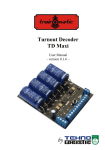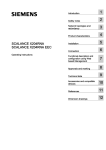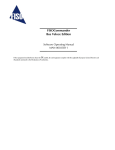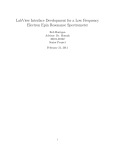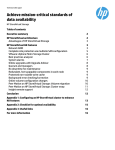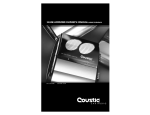Download Lab 3, Sfwr Eng 4aa3/4ga3
Transcript
Lab 3, Sfwr Eng 4aa3/4ga3 Introduction to PID controller Due: Week Starting Oct. 27, 2008 at the start of lab session. Goals: • Introduction to computer based control of a simple voltage-controllable electomechanical system - the DC motor • Learn how to create virtual input channels • Experiment with different set points and constants of a PID contoller • Estimating the DC Gain • Estimating the time constant τ Note: This lab consists of five (5) activities. Marks allocated to each are indicated in square brackets. Implementation of PID Controls Before you go for your lab session, please read the following NI documents at your own convenient time, in addition to the class notes: • Fundamentals of Motion Control http://zone.ni.com/devzone/cda/tut/p/id/3367 • Universal Power Module (UPM) user manual (Available in Labs folder on the course web page) • SRV02 rotary servo plant user manual (Available in Labs folder on the course web page) • SRV02 rotary experiments series (Available in Labs folder on the course web page) Equipment Arrangement Quanser SRV02 rotary servo plant consists of a DC motor, a gear box, a potentiometer, a quadrature encoder and a tachometer. The potentiometer output is used to implement the proportional (P) part of the PID controller. This is an analog signal and must be converted into a digital signal before it is passed on to the computer. The potentiometer is connected through a 6-pin DIN connector to S1 terminal on the Universal Power Module (UPM). UPM supplies voltage to the potentiometer and picks up the analog signal from its wiper proportional to the position of the motor shaft. The S1 output from UPM is connected to one of the analog input channels on BNC 2120 board. 1 The tachometer produces a voltage signal proportional to the angular velocity of the shaft dθ and is used to implement the derivative (D) part of the PID controller. dt The 6-pin DIN connector of the tachometer is connected to S3 terminal of UPM. The encoder is connected to the encoder 0 connector on the terminal board. Its output is used to implement the Integral (I) part of the PID controller. Output of the amplifier (LOAD terminal of UPM) is connected to power the motor. Analog output of DAC on 2120-board provides the signal to the amplifer to adjust its output according to the difference between the set point and the actual position of the motor shaft. A Labview VI implements the PID controller.On its front pannel the user can set the desired position of the motor shaft. Proportional, derivative and integral signals are received from the potentiometer, the tachometer and the encoder as described above. These signals are fed to the Labview VI implementing the controller. The difference between the set point and the actual position results in an output signal from the controller that is fed to the amplifier in UPM for adjusting its output and suitably controlling the motor shaft position. Activities in the lab IMPORTANT NOTE: IN ORDER TO AVOID EXPENSIVE DAMAGE, DO NOT TURN ON YOUR MOTOR WITHOUT APPROVAL FROM A TA. IF YOU DO NOT GET APPROVAL FROM THE TA AT THE APPROPRIATE POINTS, YOU MAY BE ASSIGNED A ZERO FOR THE LAB. 1. Create Virtual Channels[10] • Run the MAX tool (click on the National Instrument Measurement & Automation icon on the desktop) and create: – A virtual input channel called position with units degrees with a range of [-180, +180] degrees, sensor type voltage with range [-5, +5] Volts. Be sure to specify that it is range mapped and it is a single-ended referenced signal. – A virtual output channel called control with units degrees with a range of [-360, +360] degrees, with output voltage range [-10, +10] Volts. Be sure to specify that it is range mapped. – Show the channels to your TA before proceeding further. 2. The importance of Ki [25] The purpose of this exercise is to observe how an integral compensator (Ki ) improves the steady state error. • Connect the potentiometer sensor from the motor to Analog Input Channel 0. Make sure that the BNC/temp switch is set to BNC and the FS/GS switch is set to GS. • Connect Analog Output Channel 0 to the input of the operational amplifier (Ask your TA if necessary). 2 • Test the connections by right clicking on the control output and selecting Test. Change the output value to 60. The motor should start to spin. Click on the position tab and you should see a graph of the position sensor changing linearly from -180 to +180. Click on the control sensor again and set the output to 0 to stop the motor before exiting MAX. • In Labview, load the PID demo (downloadable from the labs folder of the course web page) and save it as mypid.vi. Edit this file to make the controller suitable for use with the motor. Note that the lower and upper limits on the output should be changed to -360 and +360 respectively. Save the mypid.vi file and ask the TA to inspect it before running it. Once the TA has approved your design, have the TA help you connect your design to the motor. • Set proportional gain Kp to a value of 1.2 and set the integral Ki and derivative Kd gains to 0. Test the different set points -120,-90,-45, 45, +90, +120 and record any steady state offset in the output from the setpoint. • Now set Ki to be greater than zero, between say 1 and 5. Check to see what the steady state errors at the previous set points are now. Record the steady state error values. 3. Estimating the steady state gain A[25] In this exercise estimate the angular velocity of the motor shaft and use it to 0 estimate the steady state gain = input θvoltage • Connect the motors position encoder to the digital inputs for the counter (the TA will do this for you). • The encoder has 1024 pulses/revolution. Load the BNC-2120 encoder example from the previous lab. Save the file as MotorEncoder.vi and edit the example so that it reads the correct angle for the motors position. • Create a VI called velocity.vi to do open loop control of the motor (i.e., have some sort of way of setting the analog output channel control to a desired value). Your VI should read the encoder for the position of the motor and use this to estimate the value of θ 0 ' dθ . The VI should plot dt the estimate of the derivative and have a numeric display of the sliding average of the derivative over a user-setable number of samples. HINT: You might want to see the internals of the PID block for their method of computing the derivative. • Once the TA has approved your design, have the TA help you connect your design to the motor. Test the different set points -120,-90,-45, 0, 45, +90, +120 and for each setpoint record the steady state value of your estimate of θ 0 . 4. Estimating the time constant τ [25] This exercise uses two methods for estimating the time constant τ . 3 • Open your mypid.vi file and save it as a file called pidbode.vi. Edit this file to replace the setpoint control with a basic function generator. Add in controls to allow you to change the amplitude and frequency of a reference signal into the motor control loop. Add plots of the RMS value of the reference signal and the motor position as well as a numeric display of these values. • Once the TA has approved your design, have the TA help you connect your design to the motor. Using this set up, make Ki = Kd = 0 and then tune the value of Kp until the system is critically damped (i.e. just before overshoot occurs). Record the value. Use a square wave reference signal of a reasonably low frequency to help you tune the system. • Leave Ki = Kd = 0 and Kp = K∗ . Change the input to your system to a low frequency sinusoid of amplitude 90. Increase the frequency of the sinusoid until the RMS value of the output is √12 of the RMS value of the input. 5. Post-lab Questions[15] • System Identification Analyze your data to obtain estimates of A and τ . You should have two estimates of τ from Part III of the lab. How do the two estimates compare? What do you conclude about your results? For the value of τ obtained from ωbw in Part III and the value of A obtained from Part II of the lab, what should be the value of K∗ ? What is your best estimate of the open loop transfer function Gθ (s)? • Practical Considerations In the lab we used two different sensors to estimate the motor’s position. In Part I we used a potentiometer with readings between [-5,+5] V being read by a 16-bit A/D on a Data Acquisition (DAQ) card. In Part II we used an encoder with 1024 pulses/revolution and A and B channels going into a 24-bit up/down counter also on the DAQ card. Both of these sensors have their readings scaled in software to give [-180,+180] degrees for one full revolution of the motor. – What is the resolution in both percentage and degrees of ∗ The encoder (assuming no other sources of error other than the finite number of bits)? ∗ The potentiometer read by the 16-bit A/D (assuming the potentiometer provides a perfect reading and there are no other sources of error other than the finite number of bits? ∗ The Datasheet for the NI PCI-6035E data acquisition board used in the lab lists the absolute accuracy in a [-5,+5] volt range as 1.790 millivolts (mV). How does this compare to your previous answer? Is this not unexpected? 4 ∗ In reality the potentiometer provides a voltage that has an accuracy of ±0.5% of what a perfect linear sensor would produce. What size error does this translate into in degrees? ∗ Which sensor’s estimate of θ is more accurate when the potentiometer’s tolerance is taken into account? – The analog potentiometer has a discontinuity from +5 to -5 or vice versa as the system moves beyond 180 degrees of rotation. While it is possible to take this discontinuity into account in software, what might still be a problem? – Assuming that the motor starts with the 24-bit counter initialized to zero, how many revolutions would it take for the encoder to roll over the counter possibly resulting in a large discontinuity in the estimated position (if the software does not take this into account)? What would be the approximate size of the discontinuity? – What are the advantages and disadvantages of each type of sensor? What to submit for marking? A brief report describing what you did in the lab including screen prints of the VIs that were created. Give details of the data collected in the lab and answer the post-lab questions with explanations where necessary. 5






